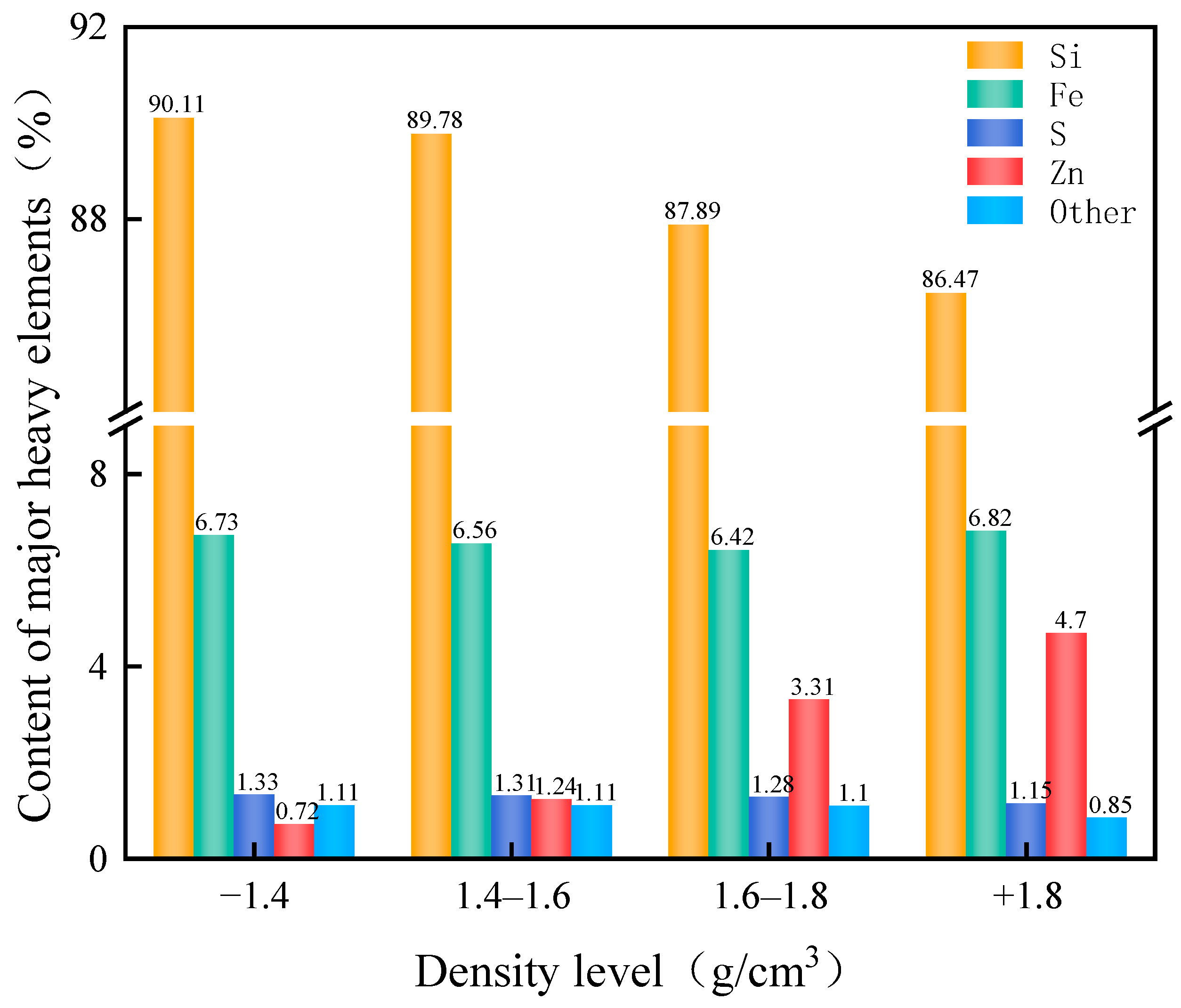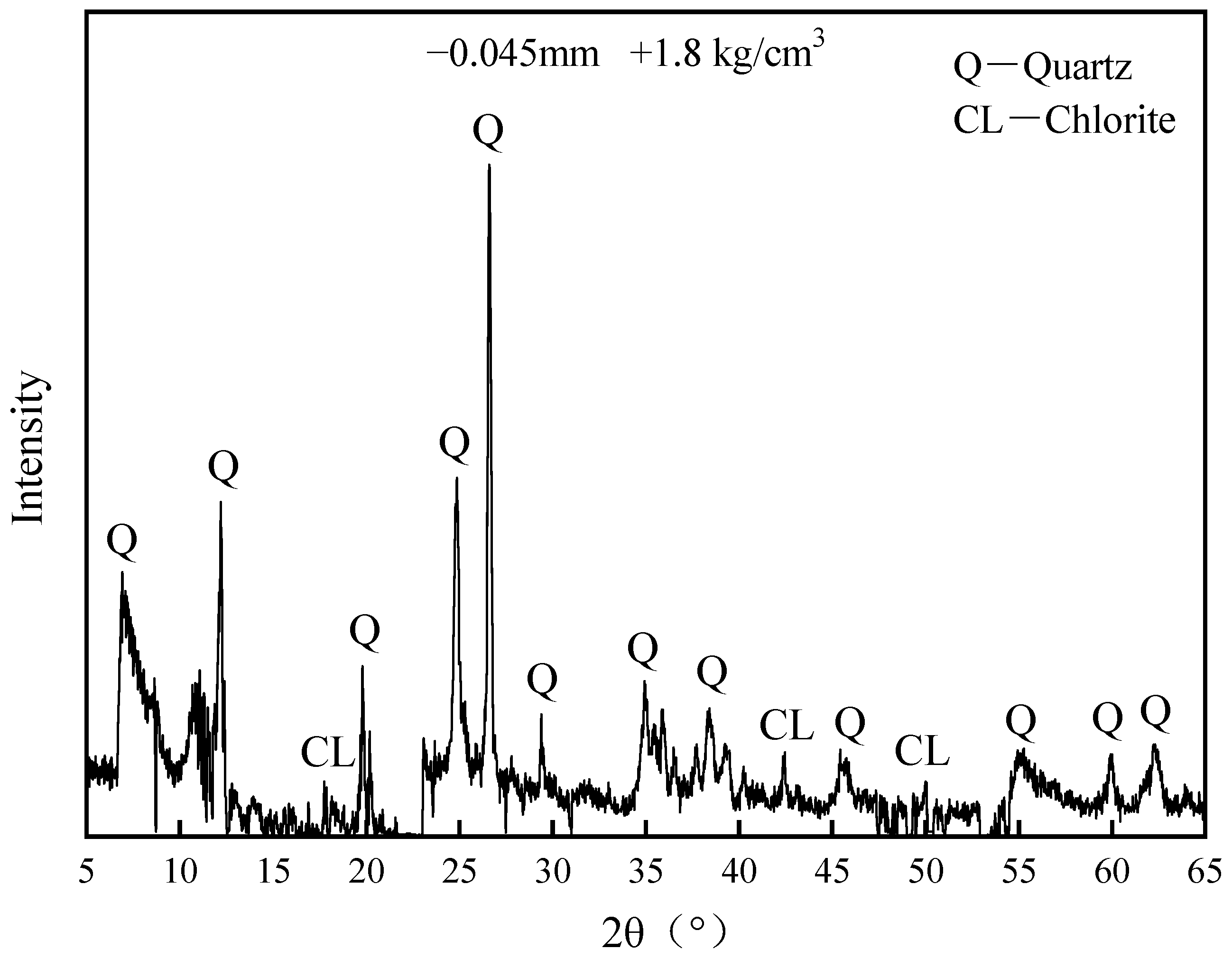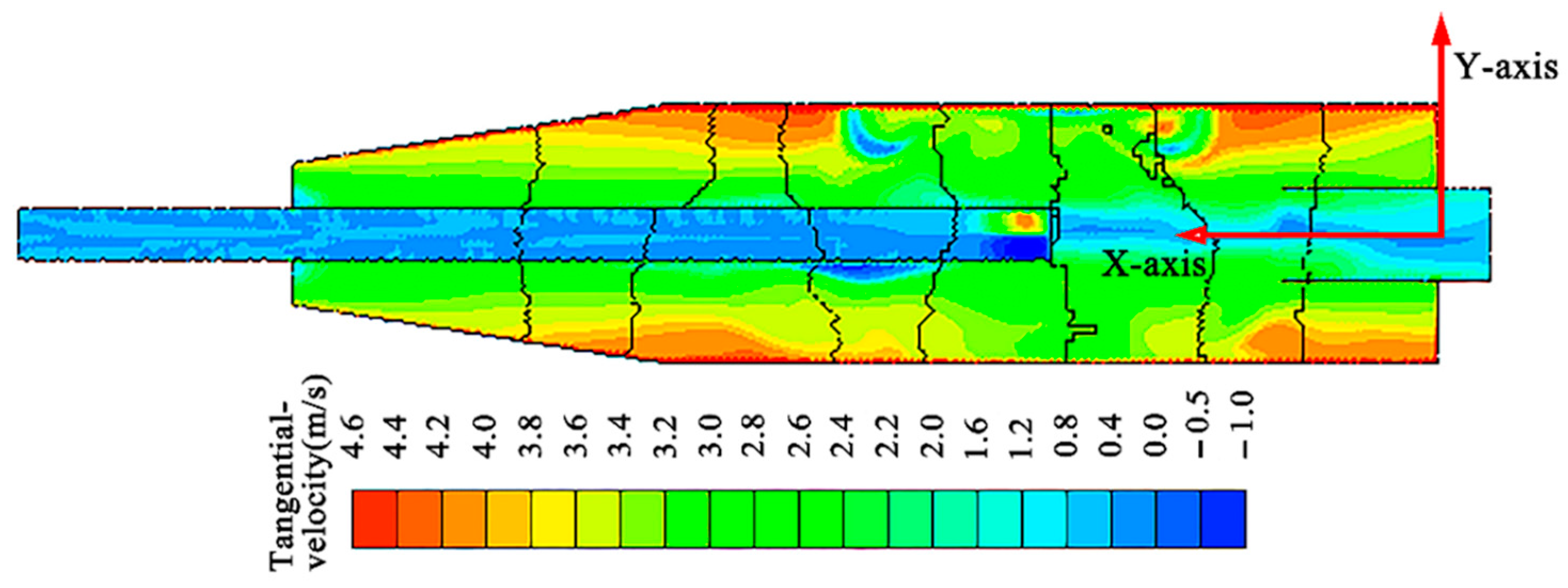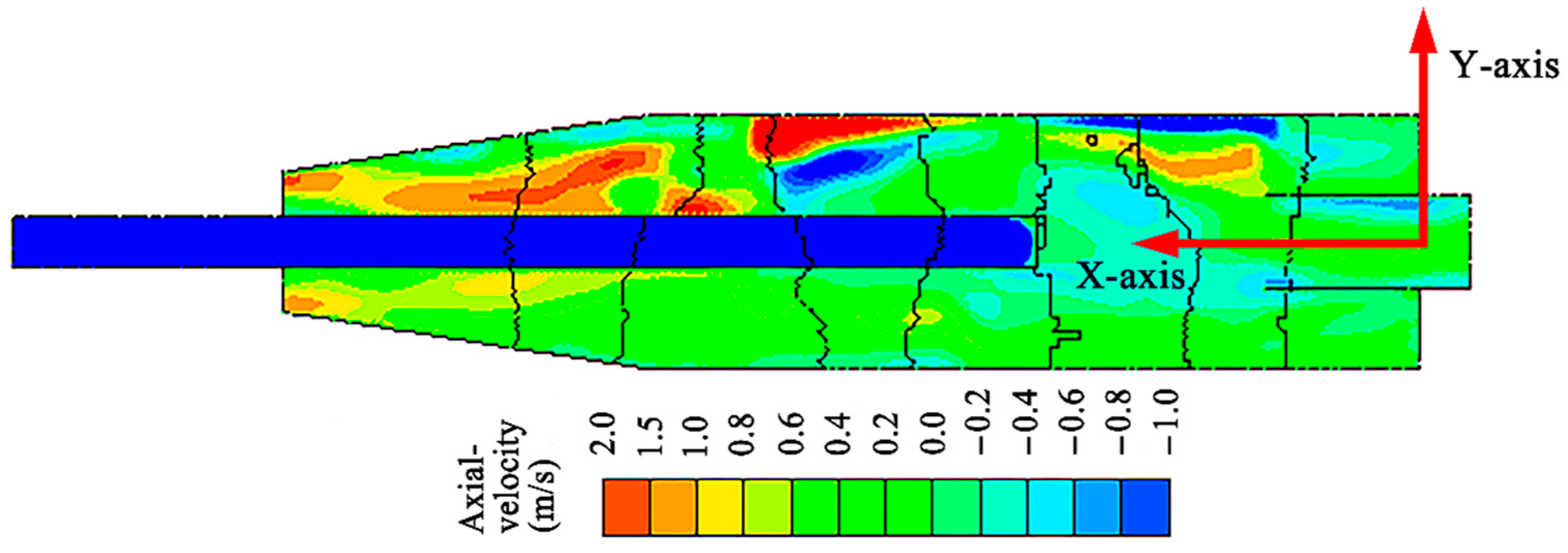Experimental Research and Practice of Mineral Separation from Flotation Tailings Based on Self-Spinning Hydrocyclones
Abstract
:1. Introduction
2. Test Materials and Analysis
2.1. Source and Treatment of Coal Samples
2.2. Material Analysis
- Particle size composition and density composition test.
- 2.
- Content and composition of mineral elements test.
3. Design of the Self-Spinning Hydrocyclone
3.1. Basic Structure
3.2. Numerical Simulation
3.2.1. Selection of the Calculation Model
3.2.2. Model Building and Mesh Division
3.2.3. Boundary Condition Setting
4. Mineral-Separation Test
5. Results and Discussion
5.1. Material Analysis Results
5.1.1. Particle Size and Density Composition
5.1.2. Results of the XRF and XRD Test
5.2. Numerical Simulation Results
5.2.1. Distribution Characteristics of Pressure
5.2.2. Distribution Characteristics of Turbulence Intensity
5.2.3. Distribution Characteristics of Velocity
- Tangential velocity distribution characteristics
- 2.
- Axial velocity distribution characteristics
5.3. Mineral-Separation Test Results
6. Conclusions
- The high-ash minerals in flotation tailings mainly concentrate in the range of −0.045 mm particle size and +1.80 g /cm3 density. Further, the main elements of the mineral-rich area are Si and Fe. An XRD test showed that the main component of the useful minerals was quartz, which has value in further separation and recovery. The determination of mineral-enrichment areas and mineral types lays a foundation for the large-scale separation and purification of useful minerals from flotation tailings.
- Using numerical simulation, the internal-flow field distribution of hydrocyclone at different rotational speeds was investigated. The pressure distribution characteristics show that the pressure increases gradually with an increase in radius and the highest pressure is at the wall surface. After the material enters the hydrocyclone, the solid particles will move rapidly from the center to the wall surface. In the same horizontal plane, the pressure value of each point is similar, which is beneficial for studying the separation function of the hydrocyclone cylinder and increasing the processing capacity of the equipment. The distribution characteristics of turbulence intensity show that the turbulence intensity at each position of the hydrocyclone is small, which is conducive to the separation process. The particles are evenly distributed according to the characteristics of the flow field, which can be adjusted with high precision.
- The distribution characteristics of tangential velocity and axial velocity were investigated by numerical simulation. First, the distribution characteristics of tangential velocity show that the tangential velocity at the relative position is basically the same along the X-axis direction. The tangential velocity points to the center line along the wall surface and gradually decreases. The maximum speed is near the wall surface. The tangential velocity is determined by the cylinder speed. Second, the axial velocity distribution characteristics show that, along the X axis, the axial velocity distribution is uneven and asymmetric and the particles are deposited on the inner wall of the cylinder, which is not conducive to the discharge of materials.
- The mineral-separation test showed that with an increase in cylinder rotation speed, the overflow yield of −0.045 mm particles increased gradually. When the rotation speed increased to 900 r/min, the overflow yield of −0.045 mm particles can reach more than 90%, which can effectively realize the material classification according to the 0.045 mm size. This provides a certain basis for the efficient separation and recovery of minerals from flotation tailings.
Author Contributions
Funding
Institutional Review Board Statement
Informed Consent Statement
Data Availability Statement
Acknowledgments
Conflicts of Interest
References
- Gao, H. Coal industry development status and supply and demand situation analysis. China Coal Ind. 2022, 3, 75–77. [Google Scholar]
- Gui, X.; Xing, Y.; Cao, Y.; Liu, J. Recent advances and thinking in process intensification of low quality coal slime flotation. J. China Coal Soc. 2021, 46, 2715–2732. [Google Scholar]
- Yan, B. Analysis on consumption and saving situation of energy in coal. Coal Process. Compr. Util. 2022, 01, 43–46. [Google Scholar]
- Tan, X.; Wang, Z.; Xiao, Q.; Ling, S.; Liu, F. Study on recovery of scheelite from the flotation tailings of a high calcium carbonate-bearing tungsten polymetallic ore. Nonferrous Met. (Miner. Process. Sect.) 2021, 6, 161–167, 188. [Google Scholar]
- Gao, X. Beneficiation technique for comprehensive recovery of rubidium and tin from fluorite flotation tailings. Min. Metall. Eng. 2021, 41, 71–75. [Google Scholar]
- Deng, M.; Liu, H. Experimental study on recovery of kaolinite from flotation tailings through removal of iron using flotation process. Coal Prep. Technol. 2021, 4, 13–18. [Google Scholar]
- Yang, Z.; Xia, Y.; Wei, C.; Cao, Y.; Sun, W.; Liu, P.; Cheng, H.; Xing, Y.; Gui, X. New flotation flowsheet for recovering combustible matter from fine waste coking coal. J. Clean. Prod. 2019, 225, 209–219. [Google Scholar] [CrossRef]
- Tang, Z.; Zhang, Q.; Sun, Y.; Gao, P.; Han, Y. Pilot-scale extraction of iron from flotation tailings via suspension magnetization roasting in a mixture of CO and H2 followed by magnetic separation. Resour. Conserv. Recycl. 2021, 172, 105680. [Google Scholar] [CrossRef]
- Zhang, B.; Xue, X.; Yang, H. A novel process for recovery of scandium, rare earth and niobium from Bayan Obo tailings: NaCl-Ca(OH)2-coal roasting and acid leaching. Miner. Eng. 2022, 178, 107401. [Google Scholar]
- Mostajeran, M.; Bondy, J.-M.; Reynier, N.; Cameron, R. Mining value from waste: Scandium and rare earth elements selective recovery from coal fly ash leach solutions. Miner. Eng. 2021, 173, 107091. [Google Scholar] [CrossRef]
- Valeev, D.; Kunilova, I.; Alpatov, A.; Mikhailova, A.; Goldberg, M.; Kondratiev, A. Complex utilisation of ekibastuz brown coal fly ash: Iron & carbon separation and aluminum extraction. J. Clean. Prod. 2019, 218, 192–201. [Google Scholar]
- Li, W.; Zhang, G.; Wang, D. Technical research status and analysis of flotation tailings reselection. Clean Coal Technol. 2021, 27, 53–58. [Google Scholar]
- Fu, Y.; Zhang, X.; Dong, X.; Yao, S. Analysis of kaolinite distribution in flotation tailings based on XRD. Multipurp. Util. Miner. Resour. 2017, 2, 79–84. [Google Scholar]
- ISO 8858-1; Hard Coal—Froth Flotation Testing—Part 1: Laboratory Procedure. Technical Committee ISO/TC 27, Solid Mineral Fuels, Subcommittee SC 1, Coal Preparation: Terminology and Performance. ISO: Geneva, Switzerland, 2019.
- Song, M.; Zhao, L.; Xu, B.; Liu, L.; Zhang, S. Discussion on technology of improving separation efficiency of liquid-liquid hydrocyclone. Chem. Ind. Eng. Prog. 2021, 40, 6590–6603. [Google Scholar]
- Liu, Y.; Zhao, L.; Zhang, S.; Liu, L.; Xu, B. Research and application of filtering-swirl coupling technology in heterogeneous separation. J. Mech. Eng. 2022, 58, 120–154. [Google Scholar]
- Ao, X.; Liu, X.; Kang, D.; Luo, R.; Liu, Z.; Yao, X. Research on parallel common liquid bucket structure of hydrocyclone based on CFD. J. Qiqihar Univ. (Nat. Sci. Ed.) 2022, 38, 11–14. [Google Scholar]
- Li, H. Design of cyclone classification control system based on Fluent. Comput. Meas. Control. 2022, 30, 128–133, 154. [Google Scholar]











| Particle Size/mm | Accounts for Sample/% | Ash Content (Ad)/% | Cumulative on the Sieve/% | Cumulative Average Ash Content (Ad)/% |
|---|---|---|---|---|
| 0.50–0.30 | 4.40 | 26.40 | 4.40 | 26.40 |
| 0.30–0.125 | 6.65 | 41.98 | 11.05 | 35.78 |
| 0.125–0.075 | 10.81 | 71.62 | 21.86 | 53.50 |
| 0.075–0.045 | 5.60 | 79.26 | 27.46 | 58.75 |
| −0.045 | 72.54 | 79.85 | 100.00 | 74.06 |
| Total | 100 | 71.62 | - | - |
| Density Level (g/cm3) | Accounts for Yield/% | Ash Content (Ad)/% | Accumulation of Floating Objects | Accumulation of Sediment | ||
|---|---|---|---|---|---|---|
| Yield/% | Ad/% | Yield/% | Ad/% | |||
| −1.40 | 0.58 | 6.59 | 0.58 | 6.59 | 100 | 79.73 |
| 1.40–1.60 | 0.58 | 18.86 | 1.17 | 12.72 | 99.42 | 80.16 |
| 1.60–1.80 | 1.85 | 33.56 | 3.02 | 25.49 | 98.83 | 80.52 |
| +1.80 | 96.98 | 81.42 | 100.00 | 79.73 | 96.98 | 81.42 |
| Total | 100.00 | 79.73 | - | - | - | - |
| Density Level (g/cm3) | Main Mineral Element Content | ||||
|---|---|---|---|---|---|
| Si | Fe | S | Zn | Other | |
| −1.40 | 90.11 | 6.73 | 1.33 | 0.72 | 0.59 (Ti) + 0.52 |
| 1.40–1.60 | 89.78 | 6.56 | 1.31 | 1.24 | 0.58 (Ti) + 0.53 |
| 1.60–1.80 | 87.89 | 6.42 | 1.28 | 3.31 | 0.59 (Ti) + 0.51 |
| +1.80 | 86.47 | 6.82 | 1.15 | 4.70 | 0.60 (Ti) + 0.25 |
| Particle Size/mm | Proportion/% | 300 r/min | 500 r/min | 700 r/min | 900 r/min | ||||
|---|---|---|---|---|---|---|---|---|---|
| Overflow Proportion/% | Underflow Proportion/% | Overflow Proportion/% | Underflow Proportion/% | Overflow Proportion/% | Underflow Proportion/% | Overflow Proportion/% | Underflow Proportion/% | ||
| 0.5–0.30 | 4.40 | 2.69 | 36.32 | 2.12 | 38.36 | 1.89 | 40.36 | 1.75 | 41.64 |
| 0.30–0.125 | 6.65 | 4.48 | 47.82 | 3.24 | 48.69 | 2.84 | 48.87 | 2.95 | 49.21 |
| 0.125–0.075 | 10.81 | 6.25 | 12.67 | 4.25 | 10.24 | 3.55 | 8.56 | 2.55 | 7.75 |
| 0.075–0.045 | 5.60 | 3.51 | 0.61 | 2.89 | 0.47 | 2.14 | 0.37 | 1.75 | 0.28 |
| −0.045 | 72.54 | 83.07 | 2.58 | 87.50 | 2.24 | 89.58 | 1.84 | 91.00 | 1.12 |
| Total | 100 | 100 | 100 | 100 | 100 | 100 | 100 | 100 | 100 |
Publisher’s Note: MDPI stays neutral with regard to jurisdictional claims in published maps and institutional affiliations. |
© 2022 by the authors. Licensee MDPI, Basel, Switzerland. This article is an open access article distributed under the terms and conditions of the Creative Commons Attribution (CC BY) license (https://creativecommons.org/licenses/by/4.0/).
Share and Cite
Zhou, W.; Wang, S.; Cai, C.; Liu, L.; Zhu, J. Experimental Research and Practice of Mineral Separation from Flotation Tailings Based on Self-Spinning Hydrocyclones. Processes 2022, 10, 1478. https://doi.org/10.3390/pr10081478
Zhou W, Wang S, Cai C, Liu L, Zhu J. Experimental Research and Practice of Mineral Separation from Flotation Tailings Based on Self-Spinning Hydrocyclones. Processes. 2022; 10(8):1478. https://doi.org/10.3390/pr10081478
Chicago/Turabian StyleZhou, Wei, Shujie Wang, Chuanchuan Cai, Liangliang Liu, and Jinbo Zhu. 2022. "Experimental Research and Practice of Mineral Separation from Flotation Tailings Based on Self-Spinning Hydrocyclones" Processes 10, no. 8: 1478. https://doi.org/10.3390/pr10081478





